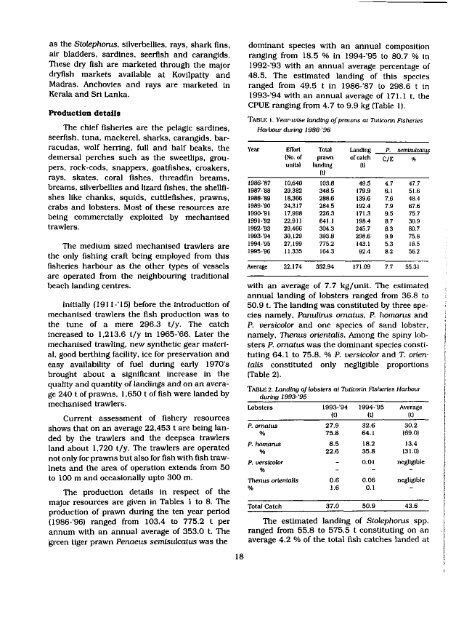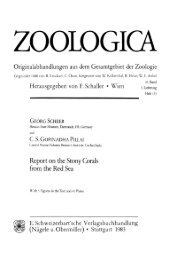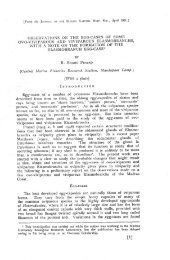marine fisheries information service - Eprints@CMFRI - Central ...
marine fisheries information service - Eprints@CMFRI - Central ...
marine fisheries information service - Eprints@CMFRI - Central ...
You also want an ePaper? Increase the reach of your titles
YUMPU automatically turns print PDFs into web optimized ePapers that Google loves.
as the Stolephoms, silverbellies, rays, shark fins,<br />
air bladders, sardines, seerflsh and carangids.<br />
These dry fish are marketed through the major<br />
dryfish markets available at Kovilpatty and<br />
Madras. Anchovies and rays are marketed in<br />
Kerala and Sri Lanka.<br />
Production details<br />
The chief <strong>fisheries</strong> are the pelagic sardines,<br />
seerfish, tuna, mackerel, sharks, carangids, barracudas,<br />
wolf herring, full and half beaks, the<br />
demersal perches such as the sweetlips, groupers,<br />
rock-cods, snappers, goatflshes, croakers,<br />
rays, skates, coral fishes, threadfm breams,<br />
breams, silverbellies and lizard fishes, the shellfishes<br />
like chanks, squids, cuttlefishes, prawns,<br />
crabs and lobsters. Most of these resources are<br />
being commercially exploited by mechanised<br />
trawlers.<br />
The medium sized mechanised trawlers are<br />
the only fishing craft being employed from this<br />
<strong>fisheries</strong> harbour as the other types of vessels<br />
are operated from the neighbouring traditional<br />
beach landing centres.<br />
Initially (1911-'15) before the introduction of<br />
mechanised trawlers the fish production was to<br />
the tune of a mere 296.3 t/y. The catch<br />
increased to 1,213.6 t/y in 1965-'66. Later the<br />
mechanised trawling, new synthetic gear material,<br />
good berthing facility, ice for preservation and<br />
easy availability of fuel during early 197G's<br />
brought about a significant increase in the<br />
quality and quantity of landings and on an average<br />
240 t of prawns, 1,650 t of fish were landed by<br />
mechanised trawlers.<br />
Current assessment of fishery resources<br />
shows that on an average 22,453 t are being landed<br />
by the trawlers and the deepsea trawlers<br />
land about 1,720 t/y. The trawlers are operated<br />
not only for prawns but also for fish with fish traw-<br />
Inets and the area of operation extends from 50<br />
to 100 m and occasionally upto 300 m.<br />
The production details in respect of the<br />
major resources are given in Tables 1 to 8. The<br />
production of pravm during the ten year period<br />
(1986-'96) ranged from 103.4 to 775.2 t per<br />
annum with an annual average of 353.0 t. The<br />
green tiger pravwi Penaeus semisulcatus was the<br />
18<br />
dominant species with an annual composition<br />
ranging from 18.5 % in 1994-'95 to 80.7 % in<br />
1992-'93 with an annual average percentage of<br />
48.5. The estimated landing of this species<br />
ranged from 49.5 t in 1986-'87 to 298.6 t in<br />
1993-'94 vdth an annual average of 171.1 t, the<br />
CPUE ranging from 4.7 to 9.9 kg (Table 1).<br />
TABLE l. Year-wise landing of prawns at Tuticorin Fisheries<br />
Year<br />
Harbour during 1986-'96<br />
1986-'87<br />
1987-'88<br />
1988-'89<br />
1989-"90<br />
1990-'91<br />
1991-'92<br />
1992-'93<br />
1993-'94<br />
1994-'95<br />
1995-'96<br />
Average<br />
Effort<br />
(No. of<br />
units)<br />
10,640<br />
29,382<br />
18,366<br />
24,317<br />
17,998<br />
22,911<br />
29,466<br />
30,129<br />
27,199<br />
11,335<br />
22,174<br />
Total<br />
prawn<br />
landing<br />
(t)<br />
103.8<br />
348.5<br />
288.6<br />
284.5<br />
226.3<br />
641.1<br />
304.3<br />
393.8<br />
775.2<br />
164.3<br />
352.94<br />
Landing<br />
of catch<br />
(t)<br />
49.5<br />
179.9<br />
139.6<br />
192.4<br />
171.3<br />
198.4<br />
245.7<br />
298.6<br />
143.1<br />
92.4<br />
171.09<br />
P.<br />
C/E<br />
4.7<br />
6.1<br />
7.6<br />
7.9<br />
9.5<br />
8.7<br />
8.3<br />
9.9<br />
5.3<br />
8.2<br />
7.7<br />
semisulcatus<br />
%<br />
47.7<br />
51.6<br />
48.4<br />
67.6<br />
75.7<br />
30.9<br />
80.7<br />
75.8<br />
18.5<br />
56.2<br />
55.31<br />
with an average of 7.7 kg/unit. The estimated<br />
annual landing of lobsters ranged from 36.8 to<br />
50.9 t. The landing was constituted by three species<br />
namely, Panulims omatus, P. homarus and<br />
P. versicolor and one species of sand lobster,<br />
namely, Thenus orientalis. Among the spiny lobsters<br />
P. omatus was the dominant species constituting<br />
64.1 to 75.8. % P. versicolor and T. orientalis<br />
constituted only negligible proportions<br />
(Table 2).<br />
TABLE 2. Landing of lobsters at Tuticorin Fisheries Harbour<br />
during 1993-'95<br />
Lobsters<br />
P. omatus<br />
%<br />
P. homarus<br />
%<br />
P. versicolor<br />
%<br />
Thenus orientalis<br />
%<br />
Total Catch<br />
1993-'94<br />
(t)<br />
27.9<br />
75.8<br />
8.5<br />
22.6<br />
-<br />
-<br />
0.6<br />
1.6<br />
37.0<br />
1994-'95<br />
(t)<br />
32.6<br />
64.1<br />
18.2<br />
35.8<br />
0.01<br />
-<br />
0.06<br />
0.1<br />
50.9<br />
Average<br />
(t)<br />
30.2<br />
(69.0)<br />
13.4<br />
(31.0)<br />
negligible<br />
-<br />
negligible<br />
~<br />
43.6<br />
The estimated landing of Stolephoms spp.<br />
ranged from 55.8 to 575.5 t constituting on an<br />
average 4.2 % of the total fish catches landed at

















